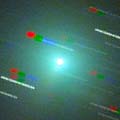
|
It brightened more rapidly than expected. Now it is bright as 7.2 mag (July 14, Maik Meyer). It is the high light in July, and it will be visible bright as 7-8 mag. However, it moves southwards very fast in August. It is only observable until mid August in the Northern Hemisphere. On the other hand, it will be observable after mid July in the Southern Hemisphere.
Date(TT) R.A. (2000) Decl. Delta r Elong. m1 Best Time(A, h)
July 14 15 3.40 54 53.9 0.575 1.119 84 7.5 19:29 (180, 1)
July 21 13 54.33 33 35.6 0.628 1.075 77 7.4 18:38 (171, 22)
|

|
It became brighter than expected, and reached to 13.2 mag (May 12, Carlos Labordena). However, it is already not observable. In the Southen Hemisphere, it will be observable again at 15 mag in November. But in the Northern Hemisphere, it will never observable again.
Date(TT) R.A. (2000) Decl. Delta r Elong. m1 Best Time(A, h)
July 14 8 50.38 16 41.6 2.735 1.807 19 13.0 18:34 (111, 0)
July 21 9 7.06 14 8.1 2.749 1.804 17 13.0 18:38 (106, -1)
|
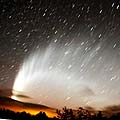
|
Excellent great comet, few times in a lifetime, for southern people. It reached to -5.5 mag on Jan. 14 and 15, brighter than Venus, and visible even in daytime. Then it appeared in the evening sky in the Southern Hemisphere and many people enjoyed a fantastic view of a beautiful great comet, a enormous curving tail with so many striae over 50 degrees. Now it is observable both in the evening and morning. It has already faded down to 12.6 mag (July 6, Walter Ruben Robledo). In the Southern Hemisphere, It keeps observable almost all night until the comet has gone. It will never be observable again in the Northern Hemisphere.
Date(TT) R.A. (2000) Decl. Delta r Elong. m1 Best Time(A, h)
July 14 12 20.04 -70 5.1 2.971 3.374 104 13.3 18:34 ( 14, 52)
July 21 12 36.01 -68 24.0 3.110 3.463 101 13.6 18:38 ( 17, 53)
|

|
It passed near by the earth in mid April, and reached to 7.6 mag (Apr. 18, Juan Jose Gonzalez). It locates high in the evening sky, and it is observable in good condition. But it already faded down to 11.4 mag visually (June 18, Carlos Labordena), and 14.1 mag by CCD (June 23, Ken-ichi Kadota). It keeps observable in good condition in the Northern Hemisphere until the comet has gone.
Date(TT) R.A. (2000) Decl. Delta r Elong. m1 Best Time(A, h)
July 14 13 15.96 58 55.0 2.104 1.991 69 13.3 18:34 (174, -4)
July 21 13 19.21 58 3.1 2.239 2.072 67 13.6 18:38 (170, -4)
|

|
It passed near by the earth in early April, and reached to 8.7 mag (Apr. 10, Werner hasubick). Then it faded down to 11.8 mag on May 26 (Seiichi Yoshida), and became too low to observe in the evening. Now it is not observable. It will appear in the morning sky again at 15 mag in August.
Date(TT) R.A. (2000) Decl. Delta r Elong. m1 Best Time(A, h)
July 14 7 11.88 25 1.7 2.501 1.493 5 13.4 5:36 (250,-16)
July 21 7 10.64 25 18.2 2.524 1.546 12 13.7 5:34 (247,-11)
|

|
It had been bright as 12-13 mag and visible visually almost always from 2006 July to 2007 April. Although it has been unobservable for a long time, now it is appearing in the morning sky finally.
Date(TT) R.A. (2000) Decl. Delta r Elong. m1 Best Time(A, h)
July 14 5 37.77 29 47.0 6.819 5.928 26 14.0 5:36 (234, -2)
July 21 5 43.71 29 50.1 6.768 5.930 31 14.0 5:34 (231, 1)
|
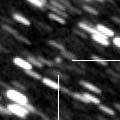
|
Now it is 15.4 mag (June 12, Ken-ichi Kadota). It will reach to 14.5 mag in summer. It moves in the southen sky, and it is observable in good condition in the Southern Hemisphere. However, it will never be observable again in the Northern Hemisphere.
Date(TT) R.A. (2000) Decl. Delta r Elong. m1 Best Time(A, h)
July 14 19 35.84 -49 54.5 2.522 3.452 151 14.4 0:12 ( 0, 75)
July 21 19 15.71 -52 8.5 2.528 3.427 147 14.4 23:18 ( 0, 73)
|
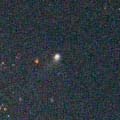
|
Now it is bright and visible visually at 13.2 mag (July 14, Juan Jose Gonzalez). It will be observable at 14 mag at high location from spring to summer both in 2007 and 2008. It will be extremely close to 189P/NEAT on July 20, and two 15-mag comets will be almost overlapping.
Date(TT) R.A. (2000) Decl. Delta r Elong. m1 Best Time(A, h)
July 14 17 28.68 -2 18.0 4.897 5.754 144 14.6 22:00 (180, 57)
July 21 17 21.47 -1 59.1 4.955 5.742 137 14.7 21:25 (180, 57)
|
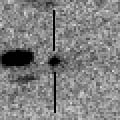
|
Now it is bright and visible visually at 14.7 mag (July 14, Juan Jose Gonzalez). It will be observable in very good condition at 14 mag from summer to autumn. However, it was not discovered at the previous apparition in 1999. So it may be bright temporarily in outburst.
Date(TT) R.A. (2000) Decl. Delta r Elong. m1 Best Time(A, h)
July 14 0 3.02 -2 57.3 1.716 2.294 111 14.8 4:38 (180, 58)
July 21 0 8.86 -3 10.8 1.642 2.289 116 14.7 4:16 (180, 58)
|
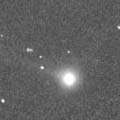
|
It had been observed while brightening rapidly until the perihelion passage on Apr. 19, although it located extremely low in the evening sky. It reached to 6.7 mag on Apr. 17 (Juan Jose Gonzalez). In the Southern Hemisphere, it appeared in the morning sky at 7.8 mag in early May (May 9, Alexandre Amorim). Then it is fading rapidly, and it has faded down to 10.9 mag on May 27 (Ken-ichi Kadota). Now it must be fainter than 14 mag. It will not be higher than now in the Northern Hemisphere after this, and it will fade out rapidly.
Date(TT) R.A. (2000) Decl. Delta r Elong. m1 Best Time(A, h)
July 14 21 12.38 -34 53.8 0.649 1.626 154 14.7 1:49 (180, 90)
July 21 20 41.98 -35 4.8 0.716 1.713 162 15.2 0:51 ( 0, 90)
|

|
It will reach to 11 mag in 2008 spring. It will keep bright for a long time, however, it keeps moving in the southern sky for a while after this. In the Southern Hemisphere, now it is low temporarily. But it will be high after July, then it keeps observable in good condition until 2008 summer. In the Northern Hemisphere, it will appear at 13 mag in November in a short time, but very low and hard to observe. However, it will be visible visually at 11 mag in the evening sky from March to June in 2008. Then it becomes unobservable again. But it will appear in the morning sky again at 13 mag at the end of 2008, then it keeps bright and observable for a while.
Date(TT) R.A. (2000) Decl. Delta r Elong. m1 Best Time(A, h)
July 14 6 51.46 -26 26.6 5.053 4.455 49 14.8 5:36 (291, 17)
July 21 7 0.69 -26 45.2 4.998 4.405 49 14.7 5:34 (289, 20)
|
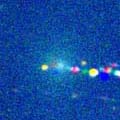
|
In the Southern Hemisphere, it is observable in the evening sky until early August while the comet is fading gradually down to 16 mag. In the Northern Hemisphere, it is not observable until when the comet becomes fainter than 18 mag. It was not discovered in last autumn when the comet located in the good condition, so it may fade out rapidly after this.
Date(TT) R.A. (2000) Decl. Delta r Elong. m1 Best Time(A, h)
July 14 9 23.57 -11 5.6 2.192 1.604 42 14.8 18:34 ( 93, 23)
July 21 9 46.09 -10 34.8 2.309 1.676 40 15.1 18:38 ( 92, 21)
|
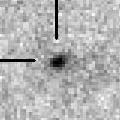
|
It appeared in the morning sky. It is bright as 14.8 mag (June 22, Ken-ichi Kadota). It will be getting higher gradually after this, and it will keep bright as 15 mag and observable in good condition for a long time until autumn.
Date(TT) R.A. (2000) Decl. Delta r Elong. m1 Best Time(A, h)
July 14 2 28.40 29 13.8 2.295 2.126 67 14.8 5:36 (200, 23)
July 21 2 40.62 31 6.1 2.243 2.141 71 14.8 5:34 (197, 22)
|

|
First return of a new periodic comet discovered in 2002. It was 16.3 mag on July 16, oberved as bright as expected. It will pass very close to the earth and reach to 15 mag in July. Although it had been only observable in the Southern Hemisphere until June, it is moving northwards rapidly, and it becomes observable in good condition in the Northern Hemisphere after July. But it will fade out rapidly after August, and will be fainter than 18 mag in September. It will be extremely close to C/2005 L3 ( McNaught ) on July 20, and two 15-mag comets will be almost overlapping.
Date(TT) R.A. (2000) Decl. Delta r Elong. m1 Best Time(A, h)
July 14 17 2.30 -15 5.7 0.198 1.182 144 15.2 21:36 (180, 69)
July 21 17 21.77 -1 50.0 0.205 1.175 137 15.3 21:28 (180, 56)
|

|
It will reach to 10.5 mag and will be observable in good condition in 2008 autumn. Now it is 15.9 mag (June 12, Ken-ichi Kadota), brightening as expected. It keeps observable in good condition for a long time while the comet is getting brighter slowly.
Date(TT) R.A. (2000) Decl. Delta r Elong. m1 Best Time(A, h)
July 14 22 3.04 -9 9.5 4.138 4.974 141 15.4 2:38 (180, 64)
July 21 22 0.05 -8 58.5 4.022 4.919 148 15.2 2:08 (180, 64)
|
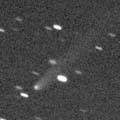
|
It has been visible at 13.5 mag for a long time since 2005 autumn until 2006 spring. It was still bright and visible visually as 14.2 mag in winter (Dec. 22, Seiichi Yoshida). However, it has already faded down to 16.7 mag (June 23, Ken-ichi Kadota). Fine tail is visible on CCD images. It will be getting lower gradually after June, and will be too low to observe in September.
Date(TT) R.A. (2000) Decl. Delta r Elong. m1 Best Time(A, h)
July 14 12 43.75 15 45.8 6.425 6.212 73 15.6 18:34 (157, 36)
July 21 12 46.31 14 55.2 6.549 6.240 68 15.7 18:38 (148, 34)
|

|
It kept 12 mag for over half a year since last June. It was still bright as 12.6 mag on Mar. 9 (Edwin van Dijk). But it has already started fading, and it is already too faint to see visually. However, the fading is slow. The comet will be fainter than 18 mag in 2008. In the Northern Hemisphere, it keeps observable until that time.
Date(TT) R.A. (2000) Decl. Delta r Elong. m1 Best Time(A, h)
July 14 5 27.66 64 45.6 3.967 3.365 47 15.8 5:36 (205,-22)
July 21 5 36.24 64 36.4 3.988 3.424 49 15.8 5:34 (204,-21)
|
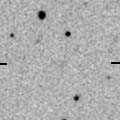
|
It was 18.2 mag on May 4 (Ken-ichi Kadota). Now it must be brightening up to 15.5 mag. But it has not been oberved at all since late May. It will approach down to 0.4 A.U. to the sun on Oct. 28, and it is expected to reach to 6 mag. However, the condition in the Northern Hemisphere is very hard. It will be getting lower in the evening sky after this. The altitude becomes lower than 20 degree in early July, and lower than 10 degree in late July. The comet is still faint as 15.5 mag at that time. After conjunction with the sun, the comet will be brighter than 11 mag in late September, and will be 8 mag in mid October. But it locates extremely low, slightly over the horizon in the morning sky. It goes to the southern sky in late October, then it will never be observable again. In the Southern Hemisphere, it becomes unobservable in July. But it will appear in the evening sky at 7 mag in early November. Then it keeps observable while fading gradually, although it will not locate very high.
Date(TT) R.A. (2000) Decl. Delta r Elong. m1 Best Time(A, h)
July 14 10 13.18 28 44.3 2.867 2.145 37 16.1 18:34 (132, 7)
July 21 10 17.65 28 37.7 2.825 2.039 32 15.8 18:38 (128, 2)
|

|
Now it is 17.2 mag (June 20, Ken-ichi Kadota). It will reach to 12 mag in 2008 summer. In the Northern Hemisphere, it keeps observable almost all time until that while the comet is brightening gradually. However, it goes to the southern sky and will never be observable again in the Northern Hemisphere after that.
Date(TT) R.A. (2000) Decl. Delta r Elong. m1 Best Time(A, h)
July 14 16 54.46 32 9.0 4.944 5.442 114 16.3 21:26 (180, 23)
July 21 16 49.24 30 59.3 4.939 5.389 111 16.3 20:53 (180, 24)
|

|
It reached up to 4 mag in 2006 autumn. But it had faded down to 10.5 mag on Jan. 11 (Carlos Labordena). It had been unobservable for a long time since that, but now it is appearing at dawn again. Now it is 16.8 mag (May 27, Ken-ichi Kadota), fading rather rapidly. After this, it keeps observable until it becomes fainter than 18 mag in autumn.
Date(TT) R.A. (2000) Decl. Delta r Elong. m1 Best Time(A, h)
July 14 22 44.72 -21 46.6 3.375 4.160 135 16.3 3:20 (180, 77)
July 21 22 38.17 -23 16.7 3.377 4.235 143 16.4 2:46 (180, 78)
|

|
First return of a new periodic comet discovered in 1998 at 14 mag. It was recovered at 18 mag in May and June. It is a bit fainter than this ephemeris, but almost as bright as predicted. It will reach to 16 mag in 2007 summer and autumn.
Date(TT) R.A. (2000) Decl. Delta r Elong. m1 Best Time(A, h)
July 14 0 20.91 -1 30.0 2.291 2.763 106 16.6 4:55 (180, 56)
July 21 0 24.48 -0 50.6 2.192 2.746 112 16.5 4:31 (180, 56)
|

|
Now it is 16.8 mag (June 18, E. Guido, G. Sostero). It will be observable at 16.5 mag in summer and autumn in 2007, and observable at 17 mag in summer and autumn in 2008.
Date(TT) R.A. (2000) Decl. Delta r Elong. m1 Best Time(A, h)
July 14 17 26.68 -25 22.1 1.715 2.651 151 16.5 21:58 (180, 80)
July 21 17 22.60 -25 0.2 1.735 2.623 143 16.5 21:27 (180, 80)
|

|
New bright comet. It is observable at 16-17 mag in 2007 summer. It will be observable brighter than 18 mag also in 2008, from spring to summer.
Date(TT) R.A. (2000) Decl. Delta r Elong. m1 Best Time(A, h)
July 14 18 50.56 0 11.4 2.554 3.507 155 16.5 23:21 (180, 55)
July 21 18 32.45 -0 42.8 2.576 3.499 150 16.5 22:35 (180, 56)
|

|
Appearing in the moring sky. No observations have been reported since January. But it must have already brightened up to 17 mag. It will reach to 13.5 mag in the southern sky in 2008 spring and summer. In the Southern Hemisphere, it keeps observable for a long time after this. However, it is only observable until autumn in the Northern Hemisphere, when the comet brightens up to 15 mag. Then it will be observable again at the end of 2008, when the comet will already fade down to 15 mag.
Date(TT) R.A. (2000) Decl. Delta r Elong. m1 Best Time(A, h)
July 14 1 29.44 -10 37.7 3.987 4.188 94 16.7 5:36 (196, 65)
July 21 1 32.22 -11 58.8 3.828 4.135 100 16.6 5:34 (183, 67)
|

|
Now it is 17.1 mag (June 12, Ken-ichi Kadota). It will be observable at 16.5-17 mag in good condition in summer.
Date(TT) R.A. (2000) Decl. Delta r Elong. m1 Best Time(A, h)
July 14 20 19.29 16 11.5 5.032 5.850 140 16.7 0:55 (180, 39)
July 21 20 11.92 16 42.4 5.011 5.850 142 16.7 0:20 (180, 38)
|

|
Observed on June 18 by Tony Farkas at 17.2 mag, but not officially announced yet. It will reach to 15 mag and will be observable in good condition in autumn. Then it keeps observable until it becomes fainter than 18 mag in 2008 spring.
Date(TT) R.A. (2000) Decl. Delta r Elong. m1 Best Time(A, h)
July 14 1 34.12 10 47.1 1.987 2.157 85 17.0 5:36 (191, 44)
July 21 1 43.74 12 45.3 1.888 2.131 89 16.8 5:34 (185, 42)
|

|
After the perihelion passage on Apr. 4, it appeared in the morning sky and it was so bright as 5.5 mag (Apr. 10, Michael Jager and Gerald Rhemann). Then it is fading rapidly. But it is bright as 13.7 mag still now (June 26, Juan Jose Gonzalez). Now the location is very good, so it will be bright for some more time.
Date(TT) R.A. (2000) Decl. Delta r Elong. m1 Best Time(A, h)
July 14 16 48.86 -9 26.3 1.183 2.062 139 16.8 21:20 (180, 65)
July 21 16 40.14 -11 17.2 1.342 2.153 131 17.3 20:44 (180, 66)
|

|
Now it is 16.7 mag (May 27, Ken-ichi Kadota). It is outside of Jupiter's orbit. So it keeps 17 mag for a long time until 2007 summer. It keeps locating high and observable in good condition for a long time after this because it moves in the northern sky.
Date(TT) R.A. (2000) Decl. Delta r Elong. m1 Best Time(A, h)
July 14 13 38.41 31 45.4 7.685 7.578 80 17.1 18:34 (175, 23)
July 21 13 38.50 30 45.0 7.792 7.598 75 17.1 18:38 (167, 23)
|
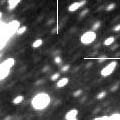
|
Now it is 16.7 mag (May 27, Ken-ichi Kadota). It is outside of Jupiter's orbit. So it keeps 17 mag for a long time until 2007 summer. It keeps locating high and observable in good condition for a long time after this because it moves in the northern sky.
Date(TT) R.A. (2000) Decl. Delta r Elong. m1 Best Time(A, h)
July 14 2 41.94 36 59.8 4.148 3.802 63 17.2 5:36 (200, 14)
July 21 2 48.60 36 57.8 4.083 3.824 68 17.2 5:34 (197, 16)
|

|
Now it is 18.1 mag (Apr. 14, Maciej Reszelski). It is observable at 17.5-18 mag until autumn. It was discovered at 18 mag in 2006. It is a distant periodic comet, and it keeps observable at 18 mag for 4 years until 2009.
Date(TT) R.A. (2000) Decl. Delta r Elong. m1 Best Time(A, h)
July 14 18 55.80 -13 10.0 3.170 4.170 167 17.3 23:27 (180, 68)
July 21 18 51.70 -13 42.3 3.186 4.166 162 17.3 22:55 (180, 69)
|
|
![]()
 C/2007 K5 ( Lovejoy )
C/2007 K5 ( Lovejoy ) 17P/Holmes
17P/Holmes 189P/2007 N2 ( NEAT )
189P/2007 N2 ( NEAT ) C/2006 OF2 ( Broughton )
C/2006 OF2 ( Broughton ) C/2003 WT42 ( LINEAR )
C/2003 WT42 ( LINEAR ) C/2006 L2 ( McNaught )
C/2006 L2 ( McNaught ) C/2007 F1 ( LONEOS )
C/2007 F1 ( LONEOS ) C/2007 G1 ( LINEAR )
C/2007 G1 ( LINEAR ) C/2006 M4 ( SWAN )
C/2006 M4 ( SWAN ) 188P/2007 J7 ( LINEAR-Mueller )
188P/2007 J7 ( LINEAR-Mueller ) 44P/Reinmuth 2
44P/Reinmuth 2 C/2007 M3 ( LINEAR )
C/2007 M3 ( LINEAR ) C/2006 U6 ( Spacewatch )
C/2006 U6 ( Spacewatch ) C/2005 S4 ( McNaught )
C/2005 S4 ( McNaught ) 50P/Arend
50P/Arend 96P/Machholz 1
96P/Machholz 1 C/2002 VQ94 ( LINEAR )
C/2002 VQ94 ( LINEAR ) C/2006 M1 ( LINEAR )
C/2006 M1 ( LINEAR ) P/2006 F1 ( Kowalski )
P/2006 F1 ( Kowalski )![]()























